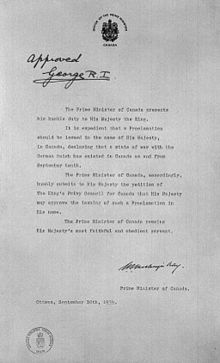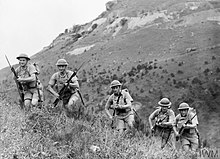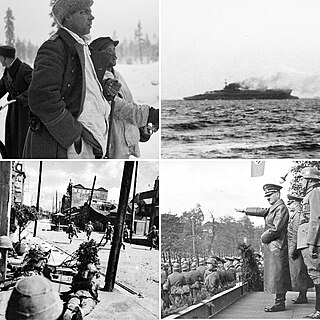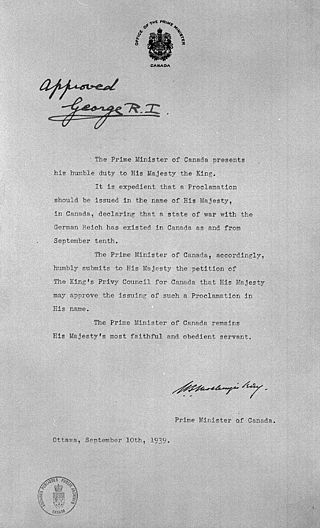Second World War
Nazi Germany

After Nazi Germany invaded Poland on September 1, 1939, the United Kingdom and France declared war on September 3. [2] To assert Canada's independence from the UK, [3] as already established by the Statute of Westminster, 1931, the Cabinet decided to seek the approval of the federal Parliament to declare war. [1] [4] [5] Parliament was not scheduled to return until October 2, but was summoned by the Governor General early on September 7 to consider the declaration of war. [7]
The House of Commons and Senate approved authorization for a declaration of war on 9 September. The Cabinet then drafted an order-in-council to that effect. The following day, Vincent Massey, Canada's High Commissioner to the United Kingdom, brought the document to George VI, King of Canada, [8] at the Royal Lodge, Windsor Great Park, for his signature, [9] [10] whereupon Canada had officially declared war on Germany. [12] In his capacity as the government's official recorder for the war effort, Leonard Brockington noted: "King George VI of England[ sic ] did not ask us to declare war for him—we asked King George VI of Canada to declare war for us." [16]
Fascist Italy
On June 10, 1940, Italy declared war on France and the United Kingdom [2] [11] and its allies. [3] Though the Canadian Minister of National Defence, Norman Rogers, had been killed in a plane crash that day, [11] Prime Minister Mackenzie King still tabled a motion in the House of Commons, stating in it:
Whereas Italy has declared her intention to enter the war on the side of Germany and against the allied powers; and
Whereas a state of war now exists between the United Kingdom and France on the one hand and Italy, on the other; and
Whereas at the outbreak of war the Parliament of Canada decided to stand at the side of the United Kingdom and France in their determined effort to resist aggression and to preserve freedom;
It is expedient that the houses of Parliament do approve the entry of Canada into a state of war with Italy and that this house does approve the same. [3]
Mackenzie King went on to explain that, after passage of the motion through Parliament, it would be presented, via Cabinet, to the King for his approval and a royal proclamation would be produced, declaring "the existence of a state of war between Canada and Italy." [3] Both houses of Parliament gave their consent to a declaration of war and the Cabinet proceeded with the aforementioned steps the same day. The proclamation, as printed in the Canada Gazette, was read by the Prime Minister to Parliament on June 11 1940. [2] [11]
Japan, Finland, Hungary, and Romania
Parliament adjourned on November 14, 1941, and was not scheduled to return until January 21, 1942. [3] However, at the urging of the Soviet Union, the United Kingdom declared war on Finland on December 6, 1941. [17] At the UK's urging, the Canadian Cabinet the next day issued a royal proclamation declaring war on Finland, [17] Hungary, and Romania, three countries that had recently allied themselves with Nazi Germany. [3]

Coincidentally, also on December 7, 1941 (December 8 in Japan), the Empire of Japan invaded Hong Kong and Malaya and attacked Pearl Harbor, followed by a declaration of war upon the United Kingdom, Canada, and the United States. [2] Mackenzie King and the rest of Cabinet decided to go to war with Japan that evening and had the Governor General issue a royal proclamation the following day asserting that, as of December 7, a state of war existed between Japan and Canada. [2] [18] The same day, the US and UK also declared war on the Japanese Empire. [2]
These proclamations were presented by Mackenzie King to the House of Commons when parliament returned on its scheduled date. Therein, the Prime Minister tabled motions for parliamentary approval of the declarations of war, [3] although permission from the legislators was not legally required. According to his diary, Mackenzie King told himself the latest declarations of war were "all part of the same war," meaning the war that had begun for Canada on September 10, 1939. The Prime Minister had thus decided there was no need for Parliament to be reconvened earlier than scheduled. Still, Parliament having not been sitting when war was declared on Japan, Romania, Finland, and Hungary was concerning to Mackenzie King. [3]

















